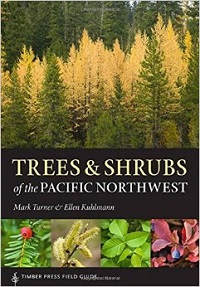I need plant suggestions for growing in cold, salty winds only 15 to 20 feet from the high water mark of the Georgia Straits. In winter, the salt water from the ocean occasionally douses the area where I will be gardening. I’m particularly interested in perennials and small shrubs.
I found a list from Island County, WA (no longer available online) with revisions added for Bay Area gardeners.
Excerpts:
“Some of the better salt-tolerant shrubs and small trees to consider include Salal (Gautheria shallon), Ocean Spray (Holodiscus discolor), Snowberry (Symphoricarpos albus), Elderberry (Sambucus species), Tall Oregon grape (Mahonia aquifolium), Serviceberry (Amelanchier alnifolia), Nootka Rose (Rosa nutkana), and the Wax Myrtle (Myrica [now called Morella] californica).
There are a variety of native plants that are commonly found near the shoreline, and which typically do well in the Puget Sound area. These include the sword fern (Polystichum munitum), Bracken fern (Pteridium aquilinum), Fireweed (Epilobium angustifolium), Coastal lupine (Lupinus littoralis), Honeysuckle (Lonicera species), and Coastal strawberry (Fragaria chiloensis).”
Washington Native Plant Society also has a list of plants for a saltwater setting.
I recently answered a question about salt-tolerant grasses which may be helpful to you as well.
The book cited in the answer above, Frances Tenenbaum’s Gardening at the Shore, also lists shrubs and perennials. Below are those which might work in zone 8 or lower, and which are smaller than 20 feet.
Shrubs:
- Acca (also called Feijoa) sellowiana (8-12 feet)
- Amelanchier (small tree/large shrub)
- Arbutus (there are some smaller species than the familiar Pacific madrone)
- Arctostaphylos patula (6 feet)
- Arctostaphylos uva-ursi (ground cover)
- Atriplex canescens (3-5 feet)
- Baccharis halimifolia (6-10 feet)
- Calluna vulgaris (from 6 inches to 2 feet)
- Caryopteris x clandonensis (2-3 feet)
- Ceanothus (many varieties of different sizes, from ground cover to 20 feet)
- Chamaecyparis lawsoniana (look for a dwarf variety of this tree)
- Clethra alnifolia (8 feet)
- Gaultheria shallon (ground cover)
- Hydrangea macrophylla (6-8 feet)
- Juniperus virginiana (look for creeping juniper cultivars like ‘Bar Harbor’ and ‘Blue Rug’ which are salt-tolerant)
- Picea glauca (look for dwarf cultivars like ‘Arneson’s Blue’)
- Rhus typhina
- Rosa rugosa
- Rosmarinus officinalis
- Syringa vulgaris
- Vaccinium corymbosum (highbush blueberry)
- Viburnum (numerous species of different sizes)
Perennials:
- Achillea
- Armeria maritima
- Artemisia ‘Powis Castle’
- Artemisia schmidtiana
- Asclepias tuberosa
- Baptisia australis
- Echinacea purpurea
- Hemerocallis ‘Stella d’Oro’
- Nepeta x faassenii and Nepeta ‘Six Hills Giant’
- Perovskia atriplicifolia [now renamed Salvia yangii]
- Platycodon grandiflorus
- Sedum ‘Autumn Joy’
 Grass Valley, California is on the outer rim of our region, but the resident gardening columnist Carolyn Singer is worth knowing about, especially for gardeners in the foothills of the Cascades. She is very experienced with the ravages of deer, and address this concern in two books. “Deer in My Garden” (2006), was largely written while the author spent the summer of 2005 in Seattle and focuses on perennials and subshrubs. “Deer in My Garden: Volume 2” (2008) considers the impact on groundcovers and garden edge plants.
Grass Valley, California is on the outer rim of our region, but the resident gardening columnist Carolyn Singer is worth knowing about, especially for gardeners in the foothills of the Cascades. She is very experienced with the ravages of deer, and address this concern in two books. “Deer in My Garden” (2006), was largely written while the author spent the summer of 2005 in Seattle and focuses on perennials and subshrubs. “Deer in My Garden: Volume 2” (2008) considers the impact on groundcovers and garden edge plants.
![[The Gossler Guide to the Best Hardy Shrubs] cover](https://depts.washington.edu/hortlib/graphix/gosslerguide.jpg)